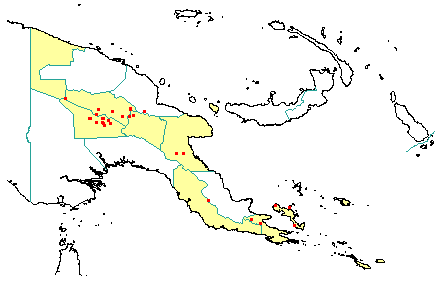
in PNGplants database
PNGTreesKey – Nothofagus carrii Steenis |
Barry Conn (NSW) & Kipiro Damas (LAE).
Guide to trees of Papua New Guinea
Copyright held by the authors, National Herbarium of New South Wales, and Papua New Guinea National Herbarium
Blumea Vol. 7: 147 (1952)
Other Literature: C.G.G.J. van Steenis, Journal of the Arnold Arboretum 359 (1953) Fig. 3-9.
Family: Nothofagaceae
Dicotyledon
Timber Group: Major exportable hardwood
Field Characters: Large canopy tree (20-45 m high); Bole cylindrical (25-130 cm diam.); straight (bole 18-24 m long); buttresses buttresses present (sometimes buttresses up to 2.5 m high) or buttresses absent; spines spines absent; aerial roots aerial roots absent; stilt roots stilt roots absent; Bark pale yellow or grey (often silvery coloured), rough, scaly or flaky or pustular, lenticels rounded/swelling; less than 25 mm thick, 10.0 (c.); bark blaze consisting of one layer; faintly to non-aromatic; outer blaze yellow (pale (initially cream-coloured), pale orange, pink, or pale red, markings absent, fibrous; inner blaze yellow (pale (initially cream-coloured), pale orange, pink, or pale red, markings absent, fibrous; bark exudate (sap) absent; terminal buds not enclosed by leaves.
Indumentum: Complex hairs absent; stinging hairs absent; mature twig indumentum (hairs) absent.
Leaves: Leaves spaced along branches, spiral (leaves occurring singly at a node and arranged spirally up the branchlet), simple (a leaf composed of a single blade); petiole present (2.5-5 mm long), not winged, attached to base of leaf blade, not swollen; leaves broadest above middle or broadest at or near middle, 2.0-6.0 cm, 1.0-3.0 cm; symmetric, entire, not dissected or lobed, emarginate or retuse, venation pinnate, secondary veins open, prominent (5-7 pairs), intramarginal veins absent; leaves lower surface pale green, upper surface dark green (sub-glossy), indumentum (hairs) absent; absent; domatia absent; stipules present, free, laterally placed, not encircling the twig, leafy (peltately attached), not fringed, large, not persistent.
Flowers: Inflorescence axillary, flowers single (female) or flowers on an unbranched axis (male in 3s (flowers surrounded by a cupule), cones absent; flowers unisexual, unisexual with male and female flowers on the same plant, not stalked (female) or stalked (male), flowers slightly asymmetric, 3.5-5.0 mm long, diameter small (up to10 mm diam.) (c. 3 mm diam.); perianth present, with all sepals and/or petals (hence tepals) similar (perianth usually 6-lobed), inner perianth pale green; 6 (-9), some or partly joined; stamens 10 (c.), present, free of each other, free of the perianth; ovary inferior, carpels joined (when more than one), locules 2-6 (-9); styles solitary (1-1.5 mm long), 1.
Fruits: Infrutescence arranged on unbranched axis, fruit 7.0-11.0 mm long, 4.0-5.0 mm diam., red or brown, not spiny, non-fleshy, simple, indehiscent, nut; seeds 1, to about 5 mm long, not winged, broad (as wide as long), seed 1-10 mm diam.
Distribution: West Sepik, Morobe, Western Highlands, Eastern Highlands, Southern Highlands, Central, Milne Bay & Papuan Islands.
 | Botanical records in PNGplants database |
Notes: Notes This species has traditionally been included in the family Fagaceae.